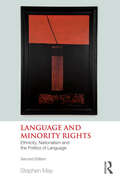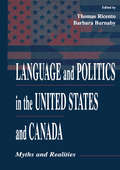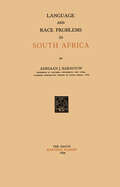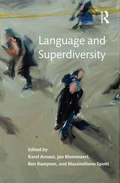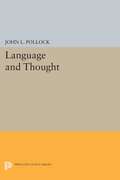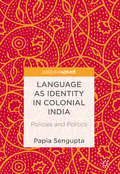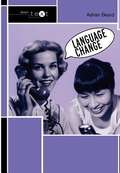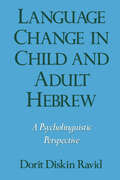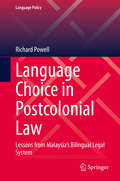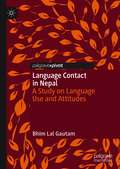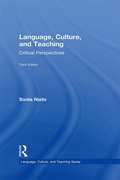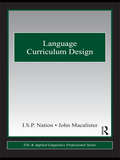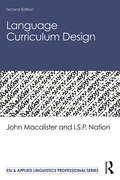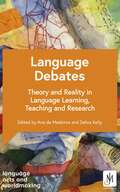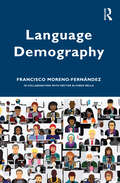- Table View
- List View
Language and Minority Rights: Ethnicity, Nationalism and the Politics of Language
by Stephen MayThe second edition addresses new theoretical and empirical developments since its initial publication, including the burgeoning influence of globalization and the relentless rise of English as the current world language. May’s broad position, however, remains largely unchanged. He argues that the causes of many of the language-based conflicts in the world today still lie with the nation-state and its preoccupation with establishing a 'common' language and culture via mass education. The solution, he suggests, is to rethink nation-states in more culturally and linguistically plural ways while avoiding, at the same time, essentializing the language-identity link. This edition, like the first, adopts a wide interdisciplinary framework, drawing on sociolinguistics, applied linguistics, sociology, political theory, education and law. It also includes new discussions of cosmopolitanism, globalization, the role of English, and language and mobility, highlighting the ongoing difficulties faced by minority language speakers in the world today.
Language and Politics in the United States and Canada: Myths and Realities
by Thomas Ricento Barbara BurnabyThis volume critically analyzes and explains the goals, processes, and effects of language policies in the United States and Canada from historical and contemporary perspectives. The focus of this book is to explore parallel and divergent developments in language policy and language rights in the two countries, especially in the past four decades, as a basis for reflection on what can be learned from one country's experience by the other. Effects of language policies and practices on majority and minority individuals and groups are evaluated. Differences in national and regional language situations in the U.S. and Canada are traced to historical and sociological, demographic, and legal factors which have sometimes been inappropriately generalized or ignored by ideologues. The point is to show that certain general principles of economics and sociology apply to the situations in both countries, but that differing notions of sovereignty, state and nation, ethnicity, pluralism, and multiculturalism have shaped attitudes and policies in significant ways. Understanding the bases for these varying attitudes and policies provides a clearer understanding of the idiosyncratic as well as more universal factors that contribute to tensions between groups and to outcomes, many of which are unintended. The volume makes clear that language matters always involve issues of culture, economics, politics, individual and group identities, and local and national histories. The chapters provide detailed analyses on a wide range of issues at the national, state/provincial, and local levels in both countries. The chapter authors come from a variety of academic disciplines (education, geography, journalism, law, linguistics, political science, and sociology), and the findings, taken together, contribute to an evolving, interdisciplinary theory of language policy.
Language and Politics in the United States and Canada: Myths and Realities
by Thomas K. Ricento Barbara BurnabyThis volume critically analyzes and explains the goals, processes, and effects of language policies in the United States and Canada from historical and contemporary perspectives. The focus of this book is to explore parallel and divergent developments in language policy and language rights in the two countries, especially in the past four decades, as a basis for reflection on what can be learned from one country's experience by the other. Effects of language policies and practices on majority and minority individuals and groups are evaluated. Differences in national and regional language situations in the U.S. and Canada are traced to historical and sociological, demographic, and legal factors which have sometimes been inappropriately generalized or ignored by ideologues. The point is to show that certain general principles of economics and sociology apply to the situations in both countries, but that differing notions of sovereignty, state and nation, ethnicity, pluralism, and multiculturalism have shaped attitudes and policies in significant ways. Understanding the bases for these varying attitudes and policies provides a clearer understanding of the idiosyncratic as well as more universal factors that contribute to tensions between groups and to outcomes, many of which are unintended. The volume makes clear that language matters always involve issues of culture, economics, politics, individual and group identities, and local and national histories. The chapters provide detailed analyses on a wide range of issues at the national, state/provincial, and local levels in both countries. The chapter authors come from a variety of academic disciplines (education, geography, journalism, law, linguistics, political science, and sociology), and the findings, taken together, contribute to an evolving, interdisciplinary theory of language policy.
Language and Social Structure in Urban France
by David HornsbyThe coming together of linguistics and sociology in the 1960's, most notably via the work of William Labov, marked a revolution in the study of language and provided a paradigm for the understanding of variation and change. Labovian quantitative methods have been employed successfully in North America, the UK, Scandinavia and New Zealand, but have had surprisingly little resonance in France, a country which poses many challenges to orthodox sociolinguistic thinking. Why, for example, does a nation with unexceptional scores on income distribution and social mobility show an exceptionally high degree of linguistic levelling, that is, the elimination of marked regional or local speech forms? And why does French appear to abound in 'hyperstyle' variables, which show greater variation on the stylistic than on the social dimension, in defiance of a well-established theory than such variables should not occur? This volume brings together leading variationist sociolinguists and sociologists from both sides of the Channel to ask: what makes France'exceptional'? In addressing this question, variationists have been forced to reassess the accepted interdisciplinary consensus, and to ask, as sociolinguistics has come of age, whether concepts and definitions have been transposed in a way which meaningfully preserves their original sense and, crucially, takes account of recent developments in sociology. Sociologists, for their part, have focused on the largely neglected area of language variation and its implications for social theory. Their findings therefore transcend the case study of a particularly enigmatic country to raise important theoretical questions for both disciplines.
Language and Social Structure in Urban France
by David HornsbyThe coming together of linguistics and sociology in the 1960's, most notably via the work of William Labov, marked a revolution in the study of language and provided a paradigm for the understanding of variation and change. Labovian quantitative methods have been employed successfully in North America, the UK, Scandinavia and New Zealand, but have had surprisingly little resonance in France, a country which poses many challenges to orthodox sociolinguistic thinking. Why, for example, does a nation with unexceptional scores on income distribution and social mobility show an exceptionally high degree of linguistic levelling, that is, the elimination of marked regional or local speech forms? And why does French appear to abound in 'hyperstyle' variables, which show greater variation on the stylistic than on the social dimension, in defiance of a well-established theory than such variables should not occur? This volume brings together leading variationist sociolinguists and sociologists from both sides of the Channel to ask: what makes France'exceptional'? In addressing this question, variationists have been forced to reassess the accepted interdisciplinary consensus, and to ask, as sociolinguistics has come of age, whether concepts and definitions have been transposed in a way which meaningfully preserves their original sense and, crucially, takes account of recent developments in sociology. Sociologists, for their part, have focused on the largely neglected area of language variation and its implications for social theory. Their findings therefore transcend the case study of a particularly enigmatic country to raise important theoretical questions for both disciplines.
Language and Superdiversity
by Jan Blommaert Karel Arnaut Massimiliano Spotti Ben RamptonA first synthesis of work done in sociolinguistic superdiversity, this volume offers a substantial introduction to the field and the issues and state-of-the-art research papers organized around three themes: Sketching the paradigm, Sociolinguistic complexity, Policing complexity. The focus is to show how complexity rather than plurality can serve as a lens through which an equally vast range of topics, sites, and issues can be tied together. Superdiversity captures the acceleration and intensification of processes of social ‘mixing’ and ‘fragmentation’ since the early 1990s, as an outcome of two different but related processes: new post-Cold War migration flows, and the advent and spread of the Internet and mobile technologies. The confluence of these forces have created entirely new sociolinguistic environments, leading to research in the past decade that has brought a mixture of new empirical terrain–extreme diversity in language and literacy resources, complex repertoires and practices of participants in interaction–and conceptual challenges. Language and Superdiversity is a landmark volume bringing together the work of the scholars and researchers who spearhead the development of the sociolinguistics of superdiversity.
Language and Superdiversity: Recombining Spaces, Times And Language Practices (Encounters Ser. #7)
by Jan Blommaert Karel Arnaut Massimiliano Spotti Ben RamptonA first synthesis of work done in sociolinguistic superdiversity, this volume offers a substantial introduction to the field and the issues and state-of-the-art research papers organized around three themes: Sketching the paradigm, Sociolinguistic complexity, Policing complexity. The focus is to show how complexity rather than plurality can serve as a lens through which an equally vast range of topics, sites, and issues can be tied together. Superdiversity captures the acceleration and intensification of processes of social ‘mixing’ and ‘fragmentation’ since the early 1990s, as an outcome of two different but related processes: new post-Cold War migration flows, and the advent and spread of the Internet and mobile technologies. The confluence of these forces have created entirely new sociolinguistic environments, leading to research in the past decade that has brought a mixture of new empirical terrain–extreme diversity in language and literacy resources, complex repertoires and practices of participants in interaction–and conceptual challenges. Language and Superdiversity is a landmark volume bringing together the work of the scholars and researchers who spearhead the development of the sociolinguistics of superdiversity.
Language and Thought
by John L. PollockMost philosophical theories of language have assumed that statements (products of assertion) and propositions (objects of belief) are the same things. John L. Pollock denies this, maintaining that even when the speaker is perfectly sincere, what he is thinking need not be the same thing as what he is saying.Originally published in 1982.The Princeton Legacy Library uses the latest print-on-demand technology to again make available previously out-of-print books from the distinguished backlist of Princeton University Press. These editions preserve the original texts of these important books while presenting them in durable paperback and hardcover editions. The goal of the Princeton Legacy Library is to vastly increase access to the rich scholarly heritage found in the thousands of books published by Princeton University Press since its founding in 1905.
Language as Cultural Practice: Mexicanos en el Norte
by Sandra R. Schecter Robert J. BayleyLanguage as Cultural Practice: Mexicanos en el Norte offers a vivid ethnographic account of language socialization practices within Mexican-background families residing in California and Texas. This account illustrates a variety of cases where language is used by speakers to choose between alternative self-definitions and where language interacts differentially with other defining categories, such as ethnicity, gender, and class. It shows that language socialization--instantiated in language choices and patterns of use in sociocultural and sociohistorical contexts characterized by ambiguity and flux--is both a dynamic and a fluid process. The study emphasizes the links between familial patterns of language use and language socialization practices on the one hand, and children's development of bilingual and biliterate identities on the other. Using a framework emerging from their selection of two geographically distinct localities with differing demographic features, Schecter and Bayley compare patterns of meaning suggested by the use of Spanish and English in speech and literacy activities, as well as by the symbolic importance ascribed by families and societal institutions (such as schools) to the maintenance and use of the two languages. Language as Cultural Practice: *provides a detailed account of the diversity of language practices and patterns of use in language minority homes; *offers educators detailed information on the language ecology of Latino homes in two geographically diverse communities--San Antonio, Texas, and the San Francisco Bay Area, California; *shows the diversity within Mexican-American communities in the United States--families profiled range from rural families in south Texas to upper middle class professional families in northern California; *provides data to correct the prevalent misconception that maintenance of Spanish interferes with the acquisition of English; and *contributes to the study of language socialization by showing that the process extends throughout the lifetime and that it is an interactive rather than a one-way process. This book will particularly interest researchers and professionals in linguistics, anthropology, applied linguistics, and education, and will be useful as a text in graduate courses in these areas that address language socialization and learning.
Language as Cultural Practice: Mexicanos en el Norte
by Sandra R. Schecter Robert J. BayleyLanguage as Cultural Practice: Mexicanos en el Norte offers a vivid ethnographic account of language socialization practices within Mexican-background families residing in California and Texas. This account illustrates a variety of cases where language is used by speakers to choose between alternative self-definitions and where language interacts differentially with other defining categories, such as ethnicity, gender, and class. It shows that language socialization--instantiated in language choices and patterns of use in sociocultural and sociohistorical contexts characterized by ambiguity and flux--is both a dynamic and a fluid process. The study emphasizes the links between familial patterns of language use and language socialization practices on the one hand, and children's development of bilingual and biliterate identities on the other. Using a framework emerging from their selection of two geographically distinct localities with differing demographic features, Schecter and Bayley compare patterns of meaning suggested by the use of Spanish and English in speech and literacy activities, as well as by the symbolic importance ascribed by families and societal institutions (such as schools) to the maintenance and use of the two languages. Language as Cultural Practice: *provides a detailed account of the diversity of language practices and patterns of use in language minority homes; *offers educators detailed information on the language ecology of Latino homes in two geographically diverse communities--San Antonio, Texas, and the San Francisco Bay Area, California; *shows the diversity within Mexican-American communities in the United States--families profiled range from rural families in south Texas to upper middle class professional families in northern California; *provides data to correct the prevalent misconception that maintenance of Spanish interferes with the acquisition of English; and *contributes to the study of language socialization by showing that the process extends throughout the lifetime and that it is an interactive rather than a one-way process. This book will particularly interest researchers and professionals in linguistics, anthropology, applied linguistics, and education, and will be useful as a text in graduate courses in these areas that address language socialization and learning.
Language as Identity in Colonial India: Policies and Politics
by Papia SenguptaThis book is a systematic narrative, tracking the colonial language policies and acts responsible for the creation of a sense of “self-identity” and culminating in the evolution of nationalistic fervor in colonial India. British policy on language for administrative use and as a weapon to rule led to the parallel development of Indian vernaculars: poets, novelists, writers and journalists produced great and fascinating work that conditioned and directed India's path to independence. The book presents a theoretical proposition arguing that language as identity is a colonial construct in India, and demonstrates this by tracing the events, policies and changes that led to the development and churning up of Indian national sentiments and attitudes. It is a testimony of India's linguistic journey from a British colony to a modern state. Demonstrating that language as basis of identity was a colonial construct in modern India, the book asserts that any in-depth understanding of identity and politics in contemporary India remains incomplete without looking at colonial policies on language and education, from which the multiple discourses on “self” and belonging in modern India emanated.
Language as Identity in Colonial India: Policies and Politics
by Papia SenguptaThis book is a systematic narrative, tracking the colonial language policies and acts responsible for the creation of a sense of “self-identity” and culminating in the evolution of nationalistic fervor in colonial India. British policy on language for administrative use and as a weapon to rule led to the parallel development of Indian vernaculars: poets, novelists, writers and journalists produced great and fascinating work that conditioned and directed India's path to independence. The book presents a theoretical proposition arguing that language as identity is a colonial construct in India, and demonstrates this by tracing the events, policies and changes that led to the development and churning up of Indian national sentiments and attitudes. It is a testimony of India's linguistic journey from a British colony to a modern state. Demonstrating that language as basis of identity was a colonial construct in modern India, the book asserts that any in-depth understanding of identity and politics in contemporary India remains incomplete without looking at colonial policies on language and education, from which the multiple discourses on “self” and belonging in modern India emanated.
Language Change
by Adrian BeardThe Intertext series has been specifically designed to meet the needs of contemporary English Language Studies. Working with Texts: A Core Introduction to Language Analysis (second edition 2001) is the foundation text, which is complemented by a range of 'satellite titles. These provide students with hands-on practical experience of textual analysis through special topics, and can be used individually or in conjunction with Working with Texts. Language Change: examines the way external factors have influenced and are influencing language change, focusing on how changing social contexts are reflected in language use explores the attitudes, values and assumptions that shape the way we use language looks at how language change operates within different genres, such as problem pages, sports reports and recipes provides lively examples from everyday communication, including letters, emails, postcards and text messages includes a unit on how new words are formed and features a full glossary.
Language Change In Child And Adult Hebrew: A Psycholinguistic Perspective
by Dorit Diskin RavidThe study of language acquisition has taken on new meaning in the last decade. Now seen as part of the study of other forms of language variation across time and space, such as dialects and sociolects, and the study of pidgins and Creoles, it can help to provide a new understanding of howlanguage evolves and what directs its development. Dorit Ravid here provides a study of contemporary speakers of Hebrew, focusing in particular on inflectional morphology. She traces language development from childhood to adulthood in Hebrew speakers, and explores strategies of language acquisitionand language processing leading to variation in the spoken Hebrew of speakers of different ages and socioeconomic backgrounds.
Language Choice in Postcolonial Law: Lessons from Malaysia’s Bilingual Legal System (Language Policy #22)
by Richard PowellThis book discusses multilingual postcolonial common law, focusing on Malaysia’s efforts to shift the language of law from English to Malay, and weighing the pros and cons of planned language shift as a solution to language-based disadvantage before the law in jurisdictions where the majority of citizens lack proficiency in the traditional legal medium. Through analysis of legislation and policy documents, interviews with lawyers, law students and law lecturers, and observations of court proceedings and law lectures, the book reflects on what is entailed in changing the language of the law. It reviews the implications of societal bilingualism for postcolonial justice systems, and raises an important question for language planners to consider: if the language of the law is changed, what else about the law changes?
Language Contact And The Future Of English (PDF)
by Ian MacKenzieThis book reflects on the future of the English language as used by native speakers, speakers of nativized New Englishes, and users of English as a lingua franca (ELF). The volume begins by outlining the current position of English in the world and accounts for the differences among native and nativized varieties and ELF usages. It offers a historical perspective on the impact of language contact on English and discusses whether the lexicogrammatical features of New Englishes and ELF are shaped by imperfect learning or deliberate language change. The book also considers the consequences of writing in a second language and questions the extent to which non-native English-speaking academics and researchers should be required to conform to ‘Anglo’ patterns of text organization and ‘English Academic Discourse.’ The book then examines the converse effect of English on other languages through bilingualism and translation. This volume is essential reading for students and scholars in English language, sociolinguistics, language acquisition, and language policy.
Language Contact in Nepal: A Study on Language Use and Attitudes
by Bhim Lal GautamThis book examines language contact and shift in Nepal, a multilingual context where language attitudes and policies often reflect the complex socio-cultural and socio-political relationship between minority, majority and endangered languages and peoples. Presenting the results of a 15-year study and making use of both quantitative and qualitative data, the author presents evidence relating to speakers' opinions and perceptions of mother tongues including English, Hindi, Nepali, Sherpa, Dotyali, Jumli and Tharu. This book explores an under-studied part of the world, and the findings will be relevant to scholars working in other multilingual contexts in fields including language policy and planning, language contact and change, and language attitudes and ideologies.
Language, Culture, and Teaching: Critical Perspectives (Language, Culture, and Teaching #23)
by Sonia NietoDistinguished multiculturalist Sonia Nieto speaks directly to current and future teachers in this thoughtful integration of a selection of her key writings with creative pedagogical features. Offering information, insights, and motivation to teach students of diverse cultural, racial, and linguistic backgrounds, examples are included throughout to illustrate real-life dilemmas about diversity that teachers face in their own classrooms; ideas about how language, culture, and teaching are linked; and ways to engage with these ideas through reflection and collaborative inquiry. Designed for upper-undergraduate and graduate-level students and professional development courses, each chapter includes critical questions, classroom activities, and community activities suggesting projects beyond the classroom context. Language, Culture, and Teaching • explores how language and culture are connected to teaching and learning in educational settings; • examines the sociocultural and sociopolitical contexts of language and culture to understand how these contexts may affect student learning and achievement; • analyzes the implications of linguistic and cultural diversity for classroom practices, school reform, and educational equity; • encourages practicing and preservice teachers to reflect critically on their classroom practices, as well as on larger institutional policies related to linguistic and cultural diversity based on the above understandings; and • motivates teachers to understand their ethical and political responsibilities to work, together with their students, colleagues, and families, for more socially just classrooms, schools, and society. Changes in the Third Edition: This edition includes new and updated chapters, section introductions, critical questions, classroom and community activities, and resources, bringing it up-to-date in terms of recent educational policy issues and demographic changes in the U.S. and beyond. The new chapters reflect Nieto’s current thinking about the profession and society, especially about changes in the teaching profession, both positive and negative, since the publication of the second edition of this text.
Language, Culture, and Teaching: Critical Perspectives (Language, Culture, and Teaching Series #23)
by Sonia NietoDistinguished multiculturalist Sonia Nieto speaks directly to current and future teachers in this thoughtful integration of a selection of her key writings with creative pedagogical features. Offering information, insights, and motivation to teach students of diverse cultural, racial, and linguistic backgrounds, examples are included throughout to illustrate real-life dilemmas about diversity that teachers face in their own classrooms; ideas about how language, culture, and teaching are linked; and ways to engage with these ideas through reflection and collaborative inquiry. Designed for upper-undergraduate and graduate-level students and professional development courses, each chapter includes critical questions, classroom activities, and community activities suggesting projects beyond the classroom context. Language, Culture, and Teaching • explores how language and culture are connected to teaching and learning in educational settings; • examines the sociocultural and sociopolitical contexts of language and culture to understand how these contexts may affect student learning and achievement; • analyzes the implications of linguistic and cultural diversity for classroom practices, school reform, and educational equity; • encourages practicing and preservice teachers to reflect critically on their classroom practices, as well as on larger institutional policies related to linguistic and cultural diversity based on the above understandings; and • motivates teachers to understand their ethical and political responsibilities to work, together with their students, colleagues, and families, for more socially just classrooms, schools, and society. Changes in the Third Edition: This edition includes new and updated chapters, section introductions, critical questions, classroom and community activities, and resources, bringing it up-to-date in terms of recent educational policy issues and demographic changes in the U.S. and beyond. The new chapters reflect Nieto’s current thinking about the profession and society, especially about changes in the teaching profession, both positive and negative, since the publication of the second edition of this text.
Language Curriculum Design (ESL & Applied Linguistics Professional Series)
by I.S.P. Nation John MacalisterCrystal-clear and comprehensive yet concise, this text describes the steps involved in the curriculum design process, elaborates and justifies these steps, and provides opportunities for practicing and applying them. The description of the steps is done at a general level so that they can be applied in a wide range of particular circumstances. The process comes to life through plentiful examples of actual applications of the steps. Each chapter includes: examples from the authors’ experience and from published research tasks that encourage readers to relate the steps to their own experience case studies and suggestions for further reading that put readers in touch with others’ experience Curriculum, or course, design is largely a 'how-to-do-it' activity that involves the integration of knowledge from many of the areas in the field of Applied Linguistics, such as language acquisition research, teaching methodology, assessment, language description, and materials production. Combining sound research/theory with state-of-the-art practice, Language Curriculum Design is widely applicable for ESL/EFL language education courses around the world.
Language Curriculum Design (ESL & Applied Linguistics Professional Series)
by John Macalister I.S.P. NationNow in its second edition, Language Curriculum Design describes the steps involved in the curriculum design process, elaborates and justifies these steps, and provides opportunities for practicing and applying them. Crystal-clear and comprehensive yet concise, the steps are laid out at a general level so that they can be applied in a wide range of particular circumstances. Updated throughout with cutting-edge research and theory, the second edition contains new examples on curriculum design and development and expanded attention on environment analysis, needs analysis, and program evaluation. The process comes to life through plentiful examples of actual applications from the authors’ experience and from published research. Each chapter also includes tasks that encourage readers to relate the steps to their own experience, and case studies and suggestions for further reading. Combining sound research/theory with state-of-the-art practice, Language Curriculum Design is widely applicable for ESL/EFL language education courses around the world.
Language Curriculum Design (ESL & Applied Linguistics Professional Series)
by John Macalister I.S.P. NationNow in its second edition, Language Curriculum Design describes the steps involved in the curriculum design process, elaborates and justifies these steps, and provides opportunities for practicing and applying them. Crystal-clear and comprehensive yet concise, the steps are laid out at a general level so that they can be applied in a wide range of particular circumstances. Updated throughout with cutting-edge research and theory, the second edition contains new examples on curriculum design and development and expanded attention on environment analysis, needs analysis, and program evaluation. The process comes to life through plentiful examples of actual applications from the authors’ experience and from published research. Each chapter also includes tasks that encourage readers to relate the steps to their own experience, and case studies and suggestions for further reading. Combining sound research/theory with state-of-the-art practice, Language Curriculum Design is widely applicable for ESL/EFL language education courses around the world.
Language Debates: Theory and Reality in Language Learning, Teaching and Research (Language Acts and Worldmaking #1)
by VariousThis book captures an urgent moment for language teaching, learning and research. At its core are a series of debates concerning gender stereotyping, the place of linguistics in modern languages, language activism, multilingualism and modern languages and digital humanities. Taken together, these debates explore the work that languages, and that those who learn and speak them, do in the world as well as the way we think 'through' and 'in' a language and are shaped by it. Language Debates acknowledges the history of language teaching and the current realities of language teaching and learning. It is bold in suggesting ways forward for reform and for policy, setting languages and language learning at the heart of a consciously transformative set of goals. This book is therefore essential reading for academics, language teachers, policy makers, students, activists and those passionate about progressing language learning and teaching. The editors and contributors make up a multilingual and multicultural team who work across languages, cultures and borders with a globally-informed approach to their work. Uniquely, the debates in this volume are based on events with participants in the Language Acts and Worldmaking Debates Series and/or workshops within the wider research project and take into account the ensuing discussions there. Each debate is accompanied by an interview which serves as a model on how to continue the conversation beyond the printed pages of the book. You can also discover ways to join the debate through links on the Language Acts and Worldmaking series website (www.jmlanguages.com/languageacts) which includes recorded debates, additional materials and more information about the series. Like all the volumes in the Language Acts and Worldmaking series, the overall aim is two-fold: to challenge widely-held views about language learning as a neutral instrument of globalisation and to innovate and transform language research, teaching and learning, together with Modern Languages as an academic discipline, by foregrounding its unique form of cognition and critical engagement. Specific aims are to:· propose new ways of bridging the gaps between those who teach and research languages and those who learn and use them in everyday contexts from the professional to the personal· put research into the hands of wider audiences · share a philosophy, policy and practice of language teaching and learning which turns research into action· provide the research, experience and data to enable informed debates on current issues and attitudes in language learning, teaching and research· share knowledge across and within all levels and experiences of language learning and teaching· showcase exciting new work that derives from different types of community activity and is of practical relevance to its audiences · disseminate new research in languages that engages with diverse communities of language practitioners.
Language Demography
by Francisco Moreno-FernándezLanguage Demography presents, exemplifies, and develops linguistic concepts involved in demography and the demographic concepts involved in sociolinguistics. The first introductory guide of its kind, it is presented in a way that is accessible to non-specialists. The book includes numerous examples of the sources and types of data used in this field, as well as the various factors affecting language demography. Taking a global perspective supported by examples, it gives explanations of how demolinguistic analyses are performed and their main applications in relation to minority and majority languages. Language Demography will be of interest to students from a range of disciplinary backgrounds, from linguistics and modern languages to sociology, anthropology, and human geography.
